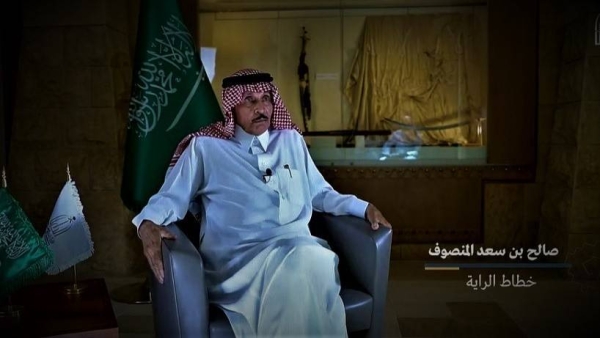
Renowned Saudi calligrapher Saleh Al-Mansouf, who was credited with inscribing the Islamic creed of monotheism with his hand and drawing the sword on Saudi Arabia’s national flag, died at the age of 86.
The death happened a few hours before the Kingdom’s celebration of its Flag Day for the first time. The funeral prayer was offered for him at Al-Babtain Mosque, north of Riyadh, and his body was buried in the North Cemetery on Saturday.
Al-Mansouf was the first Saudi calligrapher to manually write the Islamic creed of monotheism (shahada) and draw the sword on Saudi Arabia’s flag 50 years ago. He wrote shahada with his hand and draw the sword on the banner in 1381 AH (in the early 1960s), using white dye when technology and printing devices were not available.
Al-Mansouf was also among the first calligraphers whose handwriting adorned the certificates of several graduates at Imam Muhammad bin Saud University. He was also commissioned by the Riyadh Mayoralty to create calligraphy panels for use during official occasions and celebrations.
Al-Mansouf was born in the city of Riyadh where he received his first education in the Holy Qur’an memorization schools. He joined the Jabra Elementary School and then the second Intermediate School in Riyadh. After his school education, Al-Mansouf joined the Institute of Arabic Calligraphy and obtained a diploma in Arabic calligraphy and Islamic decoration.
After his graduation, Al-Mansouf honed his talent by working as a calligrapher in an office in Riyadh, and then he moved to the position of a calligrapher for the General Administration of Colleges and Institutes in 1382 at Imam Muhammad bin Saud University. Later, he was appointed editor-in-chief of the publication at the Imam Scientific Call Institute.
In his last public appearance, Al-Mansouf narrated the story of modernizing the method of writing the shahada and the sword on the banner of monotheism. He stated that the historical standard known since the period of King Abdul Aziz was the banner known as Al-Mutarrif, which was used in wars. The flag of Al-Mutarrif was sewn by placing the cloth on the same flag and then sewing it and then cutting the ends of it so that the letters of the flag stand out, Al-Mansouf said, adding “Mansour bin Mutarrif, the bearer of the Saudi flag Al-Bairaq, asked me to design it in a way that reduces its weight and easier to carry.”
It is noteworthy that the Saudi national flag is distinguished as the only flag in the world that does not fly at half-mast to mark occasions of mourning or disasters or other occasions. It is also forbidden to allow it to touch land and unclean water or enter unclean places with it or sit on it, because of the religious connotation it carries in addition to the shahada and the Arab sword that symbolizes patriotism.
The flag was inherited from the banner that Al-Saud rulers carried when they were propagating the religion and expanding their areas of influence during the first Saudi state. At that time, the color of the flag was the same green and that was made of the finest types of silk. The present-day Saudi flag is the same banner that the soldiers of the first and second Saudi states carried since the inception of the first Saudi state in 1727.
Ever since the foundation of the first Saudi state, the national flag has been a symbol of strength, sovereignty, and national unity. For nearly three centuries, the flag has been a beacon, haven, banner, and testimony of the unification campaigns that the Saudi state has undergone. Custodian of the Two Holy Mosques King Salman issued a royal decree on March 1 designating March 11 every year as a special day to celebrate the national flag.











